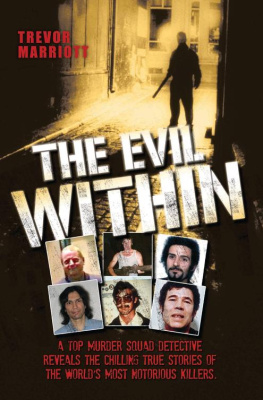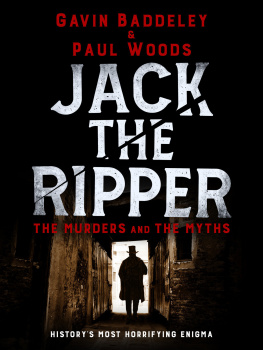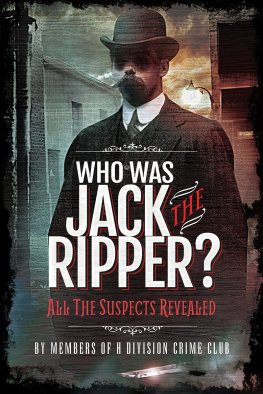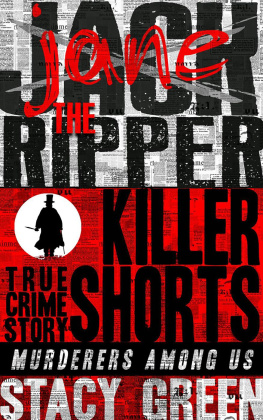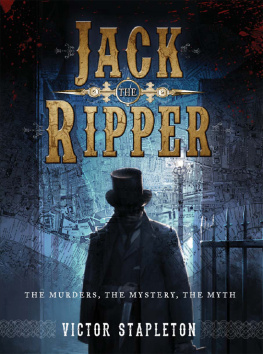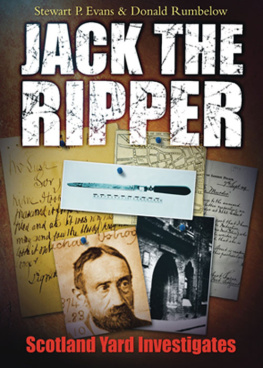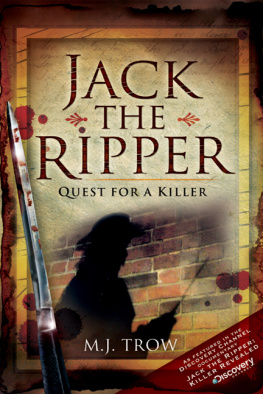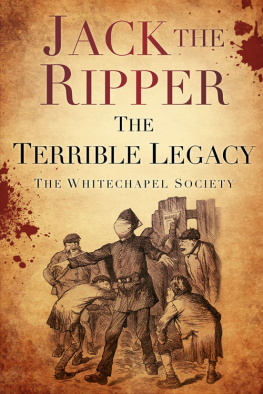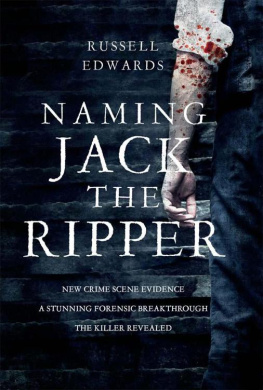
CONTENTS
J ack the Ripper: man or myth, fact or fiction? Whoever he was, his identity remains a mystery. The horrendous murders attributed to the unknown killer spread terror among the residents of Londons East End and soon his nickname was known the world over.
Jack was the most common alias for a man, real or fictitious, in Victorian times, a few examples being Jack Tar, Jack OLantern and Jack Frost. And the name Jack the Ripper set a trend in evocative nicknames for murderers, and since then there have been the Yorkshire Ripper, the Boston Strangler, the Axeman of New Orleans and many more.
Between April 1888 and July 1889 an area of east London witnessed a series of horrific murders, initially known as the Whitechapel murders. All of them remain unsolved to this day. The unidentified killer, who soon came to be known as Jack the Ripper, stalked the dimly lit, fog-blanketed streets of the East End with a single, brutal ambition murder. With malice a forethought, and under the cover of darkness, he lurked in the shadows, awaiting his prey, before slaughtering and butchering the helpless street women of the area.
Once the terrifying string of murders had begun, where would it end? Would the killer be caught? Who would turn out to be the most notorious serial criminal of all time? It was the officers of Scotland Yard and the City of London Police who were entrusted with the task of apprehending the brutal killer. They failed to do so, but did they fail honourably? Some researchers have suggested the police, in fact, knew who the killer was but, for reasons known only to the higher echelons of the police and the government, they chose not to bring the culprit to court or ever to reveal his identity and therefore were complicit in one of the biggest criminal cover-ups of all time.
In 1888, the police did not have the benefit of modern forensic methods, such as DNA testing and fingerprinting, which are readily available to police officers today. They had to rely on old-fashioned methods of detecting crime: catching the criminal committing the crime; finding witnesses who saw the crime being committed; or arresting a person on suspicion of having committed the crime, in the hope that he or she would confess.
More than a century has passed since the Rippers crimes were committed, yet the search for his identity still goes on. In fact, the mystery has deepened so much that the truth about the murders is thoroughly obscured. Innumerable press stories, books, plays, films and even musicals have dramatised and distorted the facts, with the unfortunate result that the public accepts the fiction more readily than the reality.
So, how did I, a modern-day criminal investigator, come to be interested in these horrific murders? It all goes back to the early 1960s, when I went to a concert and saw, for the first time, a pop singer by the name of Screaming Lord Sutch, who, as Lord Sutch, later became the leader of a British political party known as the Monster Raving Loony Party. Sutch had just released a record called Jack the Ripper, which became a minor hit, and when performing the number on stage he portrayed the killer and acted out the murders. He went on to perform this grisly routine in dance halls around Britain and Europe. I saw Sutch many times but I guess that on hearing his song for the first time is when my interest in Jack the Ripper was born.
After joining the Bedfordshire Police in 1970, I was in uniform only a short while before being promoted to the Criminal Investigation Department (CID), where I worked on many murders. As well as serving in various specialist police departments, including those dealing with burglary and robbery, I spent a short time in Special Branch. All the while, my fascination with the Whitechapel murders grew, to the extent that I knew that some day I would have to satisfy my curiosity. Later, with a great deal of free time on my hands, I made the decision to reinvestigate these unsolved murders. I felt that all the experience, knowledge and insight into the criminal mind I had gained by interviewing and talking to murderers, rapists and robbers would be invaluable in my attempt to view the murders through the eyes of the killer or killers, as the case might be.
I would look closely at the murders themselves, the victims and the suspects at the time, and at both the evidence available at that time and the new evidence and new suspects that have emerged in the intervening years. I would also need to analyse the new evidence recently put forward, with a view to either proving or disproving some of the accepted theories about the murders which have been with us for many years. In doing so, I hoped I might find something new that would unlock the mystery of Jack the Rippers identity.
What I discovered during my investigation was startling. The result is that I feel I can now introduce a major doubt into the number of Whitechapel murders, the suspects and, in fact, the whole mystery of Jack the Ripper.
Before analysing the murders, I decided to get an idea of what life was like in the East End in 1888. All the murders were committed in squalid, poor areas and all the victims were prostitutes. In those days, many prostitutes were forced to work the streets by gangs who inflicted violence on these poor women if they did not obey them and hand over money they earned through prostitution. It is documented that, at the time of the murders, there were some 1,600 prostitutes in the East End.
The population of the whole area is believed to have been about 900,000, 80,000 of whom resided in Whitechapel. The poor made up about 8 per cent of the population of the East End and consisted of men, women and children who worked as builders, market porters, dock workers or in other trades, earning a meagre but regular income of between 18 and 21 shillings a week. (Before decimalisation, 20 shillings equalled 1.) The very poor totalled about 11 per cent of the population and their income fell below this level. If the first group struggled to make ends meet, the second lived in utter poverty. Two per cent of the population was designated as being of the lowest class: down-and-outs and the homeless. In one district alone, it was documented that there were 146 registered lodging-houses, with more than 6,000 beds, for such people. Some of these premises contained as few as four beds, while others had as many as 350. For those who could not afford lodgings there was no other option but to sleep in the streets and alleys.
VICTIMS
I t is widely accepted that Jack the Ripper killed five women. However, my investigation revealed that nine women were murdered. All were killed in similar circumstances and all the murders occurred in or near Whitechapel, east London, between 2 April 1888 and 13 February 1891. So, has everyone been wrong all these years? Were the police of the day blinkered in the way they investigated the murders? Did the Ripper kill the canonical five women? Or was it more? Or was he responsible for fewer murders than he has been given credit for? Could another person or persons have murdered some of the victims? All are interesting questions that I hoped to be able to answer as a result of my investigation.
Who were the women murdered during this reign of terror? In Part One, I discuss each victim in chronological order and in doing so draw on the inquests conducted by Her Majestys Coroner. These reports not only helped me to build up a better picture of each victim but also gave me the opportunity to assess the police investigation and any other evidence which may have come out during the course of the inquests but which may have been overlooked. The inquest reports from which I quote are as reported in
Next page

